Dolphins, sharks, and sea turtles aren’t the only marine life that make their home on the Alabama Gulf Coast. If you’ve ever seen that purple beach flag flying, that’s a heads-up that jellyfish may be cruising the coast! These wobbly wonders are common in Gulf waters, and while some can pack a painful punch, others are as harmless as a summer breeze. And let’s face it: getting stung by a jelly is almost a rite of passage for any beach-goer, right?
But don’t worry! At Sail Wild Hearts, we know the jellyfish drill. Whether you’re curious about spotting them or keen to avoid their sting, we’ve got all the tips and tricks you need to stay safe and make the most of your adventure.
Common Jellyfish on the Alabama Gulf Coast
Up to 60 different types of jellyfish make their home in the Gulf of Mexico, but only seven species are commonly seen cruising on our coastline. Here’s a breakdown of the ones you’re most likely to meet:
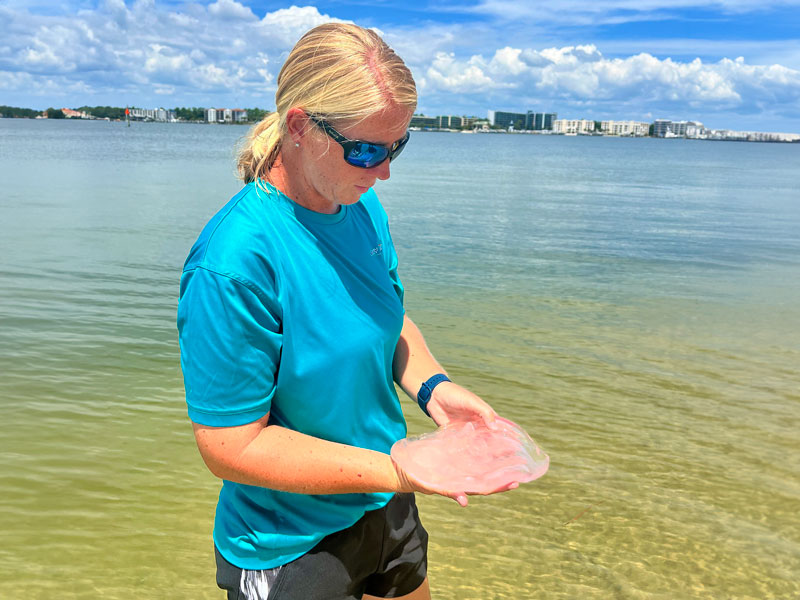
Moon Jellyfish
Imagine these big, squishy beauties as the gentle giants of the sea. Moon jellies have a clear, round bell (picture a floating full moon) lined with hundreds of short, fine tentacles that draw in and paralyze small prey. But sailors and swimmers have little to fear; their stings are so mild you might not even feel it. Our own Deckhand Brittney loves to show our young sailors how to hold moon jellies in their hands for a slimy, squishy adventure! (Wondering about our moon jellies’ wellbeing? No need! Brittney always gently returns them to the water.)
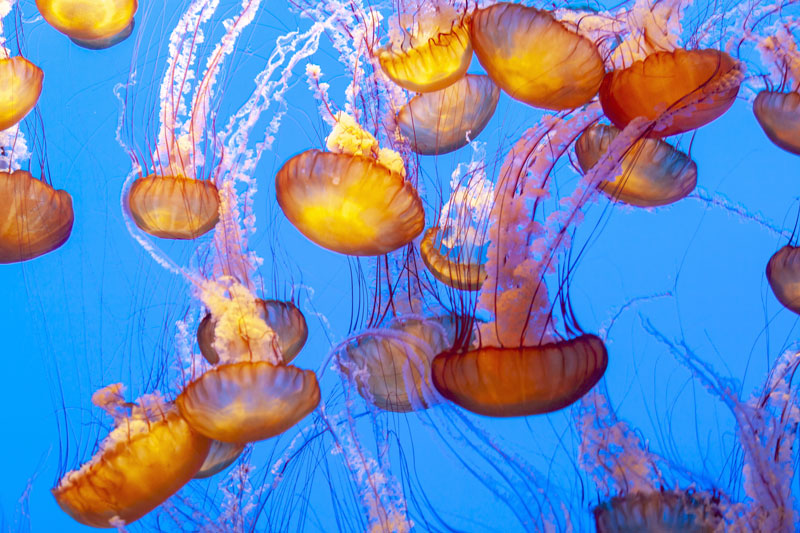
Sea Nettles
Sea nettles are one of the most common stingers in our waters, with long, trailing tentacles and a bell that can range from reddish-brown to yellow. Their sting packs more of a punch than moon jellies, but it’s not dangerous—just a bit of a wake-up call if you get too close!
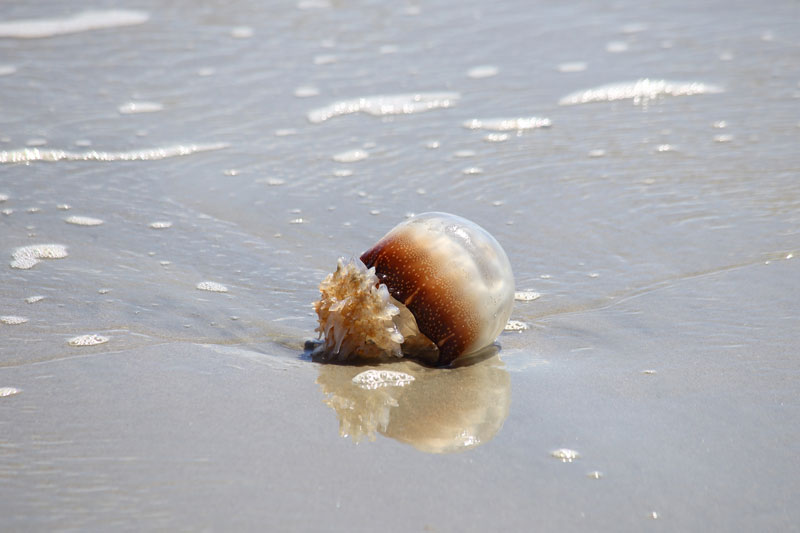
Cannonball Jellies
These round, compact jellies look like little sea bombs but are more bark than bite. Their sting is mild, and they’re easily recognizable by their firm, dome-shaped body, making them another jelly you might bump into without too much trouble.
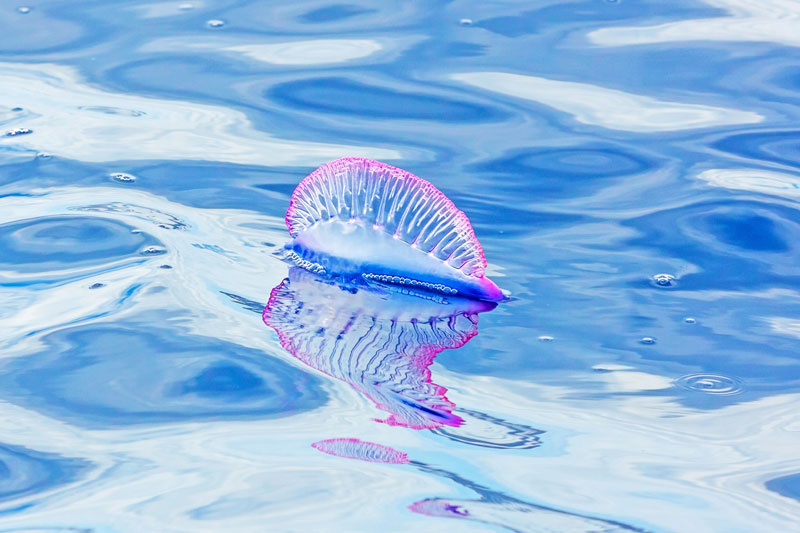
Portuguese Man o’ War
Not technically a jellyfish, but they get lumped in. With long tentacles and a striking blue color, these guys are rare but pack a powerful sting, so give them plenty of space!
How to Spot and Avoid Jellyfish on Alabama’s Beaches
Keep your eyes peeled on calm, warm days, especially in late summer and fall. Jellies love the warmer waters, and you’re more likely to spot them floating near the surface on still days.
- Pay attention to the beach flags: When purple flags are flying, it means marine pests are present. While it occasionally signals sharks, it usually means a jellyfish swarm is offshore. This is especially true during peak jellyfish season from July to October.
- Check the water: If you see jellies bobbing around, it’s best to keep a safe distance.
- Protect your skin: Consider wearing a wetsuit or rash guard if you’re scared or sensitive to jellyfish stings. These will add an extra layer of protection for your skin.
- Listen to your guides: When you’re on one of our sails or cruises, when possible our crew will let you know if jellyfish are around so you can avoid unwanted stings!
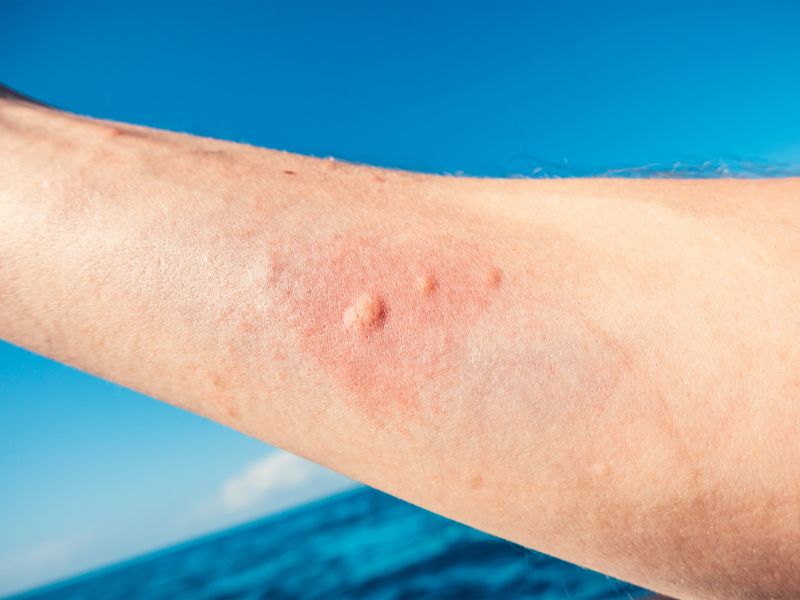
How to Treat a Jellyfish Sting
There are almost as many wives’ tale remedies for stings as there are jellyfish in the sea! Even experts still debate the best ways to treat a jellyfish sting, but there are some first aid steps you should definitely follow. Here are the basics to help ease the burn:
- Rinse the area. Rinse the sting area clean with saltwater. Do not use fresh water (bottled or tap water) as this can cause the stinging cells to release more venom.
- Remove tentacles. Remove any visible tentacles with a pair of tweezers or gently scrape the edge of a credit card across the area in a downward motion. Do not use your bare hands!
- Soak the area in hot water. Once the area is clean and tentacle-free, soak it in tolerably hot water for at least 20 minutes. Some guides suggest pouring household vinegar over the area to neutralize the sting, but this is only recommended if you know the species of jellyfish that stung you; in some cases, such as man-o-wars and sea nettles, vinegar can actually make the stinging worse.
- OTC medications. You can apply hydrocortisone cream or lidocaine to the area if needed. Painkillers like acetaminophen and ibuprofen can also help reduce pain and swelling.
If you get stung, DO NOT:
- Urinate on it
- Apply meat tenderizer or alcohol
- Rub the area with a towel
- Use pressure bandages

Get to Know Jellyfish (Safely!) on Our Cruises
Want to see jellyfish up close—without the sting? Hop aboard one of our Orange Beach cruises, where you can learn all about marine life from our knowledgeable crew (and maybe even meet a moon jelly or two if Brittney is around!). It’s the perfect family-friendly adventure, offering plenty of up-close encounters with wildlife that will make your trip unforgettable. Browse our cruises and book today!



